Pascale Petit's Blog, page 2
November 9, 2017
Strange Birds of the Peruvian Amazon, Writing Mama Amazonica
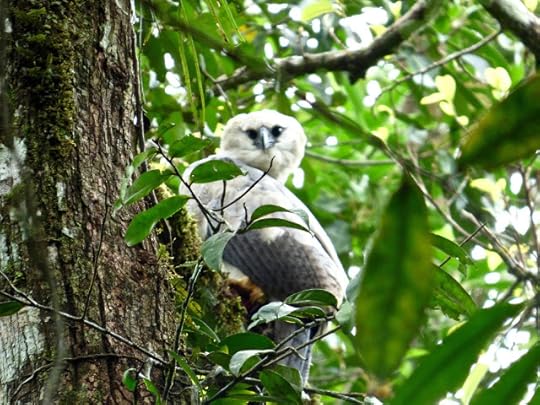
After the miracle of seeing a jaguar in the wild, comes the miracle of seeing the jaguar-of-the-skies, or harpy eagle. We saw this juvenile on our first trip in June 2016, and a chick in the nest on our second trip in December of that year. We also caught a glimpse of the mama! She is larger than the male, with a 2 metre wingspan, and she crashed through the canopy in a flash of ivory and black, like a giant Holy Ghost. She is the most powerful eagle in the world, with harpy talons. She was a visitation, a Mama Amazonica, and I tried to write about her in my seventh collection Mama Amazonica (Bloodaxe, 2017), in a poem that also features that armadillo the juvenile eagle is clutching in his talons as he learns to hunt. The juvenile gawped at us for at least half an hour, and didn't quite seem to know what to do with his catch, you can just spot the armadillo tail below him. On our way down over the tangle of hillside roots, we saw the hole the armadillo once lived in.
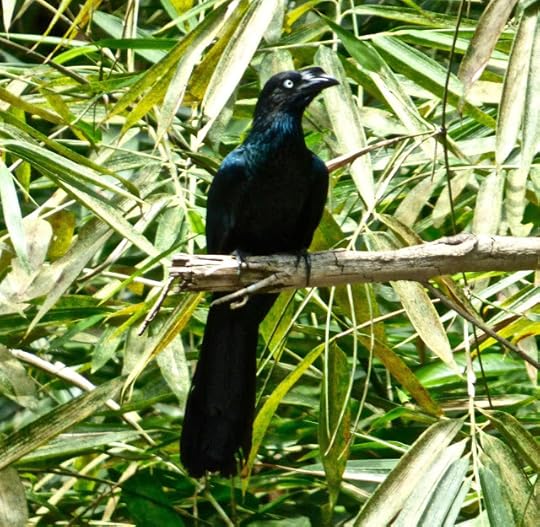
This is a greater Ani. They make a strange coughing or croaking sound and cluster at oxbow edges and forest margins.
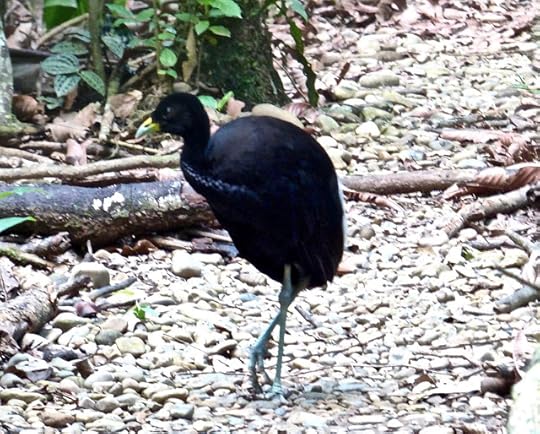
The most haunting song in the Amazon basin is surely from the pale-winged trumpeter just before dawn. The first time I heard it I thought that maybe it was a generator coming on, though Tambopata Research Center doesn't use generators but solar panels for energy. I thought of the wind playing overhead cables like a harp. And I thought of aliens – surely they had landed in the forest depths? It was a vibrato hum that went right through me and made the roof of my mouth tingle. It was almost four am, two hours before equatorial dawn, and the male howler monkeys had not yet started the first rumbles of their thunderous roars. The titi monkeys were still asleep and had not yet uttered their quarrelsome screaming barks. As the trumpeters faded, bats crashed into the network of strings overhead, a mesh designed to stop roof-nesting tarantulas from dropping on guests in their bed, or at least onto our mosquito veils which swathed the beds. My room was a cubicle in a traditional Ese-Eja wooden long house made from palm leaves, the outer wall open to the night and the jungle. The jungle frequently invaded: macaws, mouse possums, wolf spiders, bats, and who knows what, gobbled any food left out of the safe.
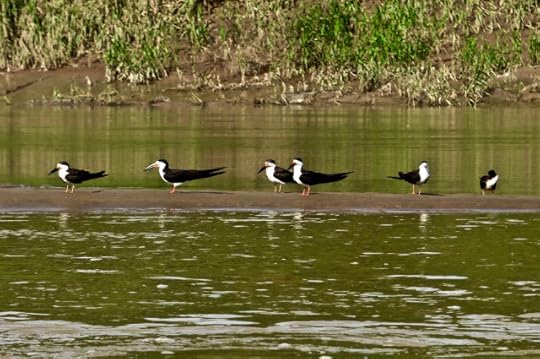
These are black skimmers, quite rare I think, we didn't see many. Here they are on a sandbank on the Tambopata.
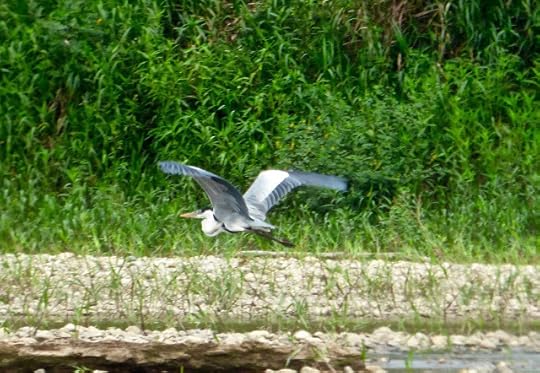
A cocoi heron, saw many of these along the river and in oxbow lakes, larger than European herons.
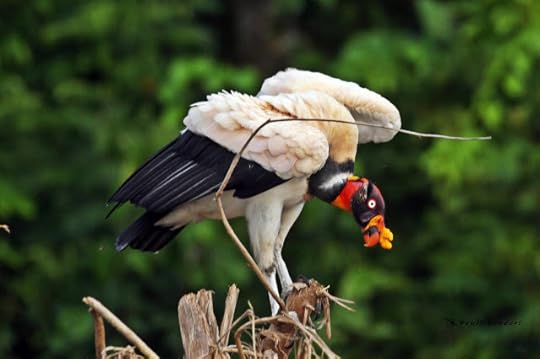 The magisterial king vulture, photo by our guide Jungle Paul. All the other pics are by Brian Fraser.
The magisterial king vulture, photo by our guide Jungle Paul. All the other pics are by Brian Fraser.Another miracle – I have written and read legends about these kings for decades. First time I saw them they were flying above TRC, the second time was here on the riverbank, scroll down to the next pic for the story! I've also seen them in the zoo of the Jardin des Plantes in Paris, even a chick in the nursery! That couple, N'goro anhd Margo are ancient. There's a poem about them in Fauverie.
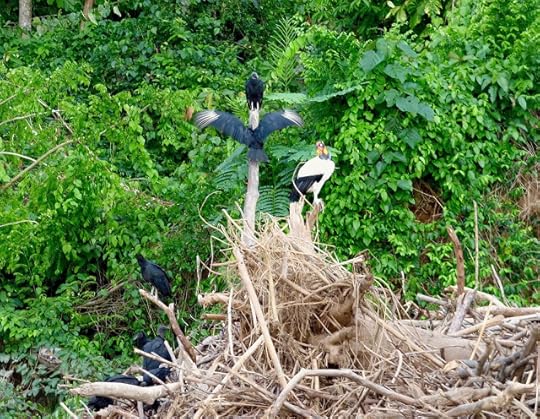
So here are the two king vultures, always first at the feast, while the black vultures and black hawks wait for their turn. The 'feast' is a giant golden catfish that's caught by a spectacled caiman. I've written about that incident in a previous post, but the gist of it is that the caiman had his snout up the catfish's thorax. It was the king vultures that drew us to the pile of driftwood, where we discovered the unfolding drama. The black hawks are waiting to eat the catfish, but might also follow the caiman to his lair, to eat his babies.
Published on November 09, 2017 10:01
September 9, 2017
Some mammals of the Peruvian Amazon: research for Mama Amazonica
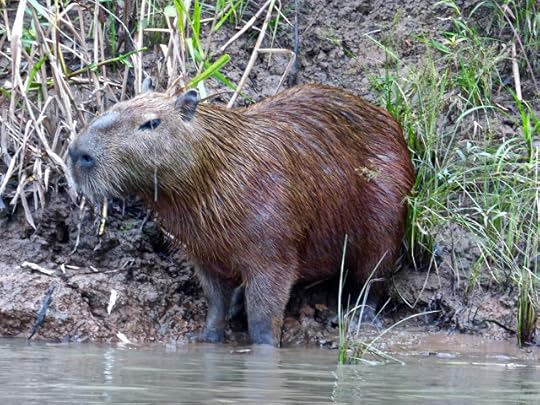 Capybara on Tambopata riverThere are other mammals in
Mama Amazonica
– a wolverine, a snow leopard and two giraffes – but it's the Amazonian ones that I'm obsessed with. I love wolverines, have read everything about them, and watch the two at Vincennes zoo in Paris every time I go there, snow leopards are special though the only ones I've seen are in zoos too, and the herd of giraffes at Vincennes fascinate, but nothing comes close to jaguars for me. They are the pitbulls of the cat world, muscular, with jaws that could crack the moon, yet otherworldly, with their coats of stars or giant hooker's green waterlily leaves slowly drifting across a sunlit lake.
Capybara on Tambopata riverThere are other mammals in
Mama Amazonica
– a wolverine, a snow leopard and two giraffes – but it's the Amazonian ones that I'm obsessed with. I love wolverines, have read everything about them, and watch the two at Vincennes zoo in Paris every time I go there, snow leopards are special though the only ones I've seen are in zoos too, and the herd of giraffes at Vincennes fascinate, but nothing comes close to jaguars for me. They are the pitbulls of the cat world, muscular, with jaws that could crack the moon, yet otherworldly, with their coats of stars or giant hooker's green waterlily leaves slowly drifting across a sunlit lake. I knew I would probably not see one in the rainforest, or at its margins along the riverbank. So I teased the guide and he humoured me, scheduling extra rivertrips on both of my visits to Peru. We saw so many creatures, and here are just some of them, along the banks or up in the treetops. But no jaguar. Not even an ocelot.
Until the journey back from the research lodge deep in Tambopata National Reserve, back to the lodge in the buffer zone hours downriver. Scroll down and you can see him, and I've written about him before in a previous post. I've also tried to write about him in the last poem in Mama Amazonica, struck by Pablo Neruda's line "like a river of buried jaguars" from The Heights of Macchu Picchu.
Imagine seeing a jaguar in his vast home, the place that takes hours to cross by plane!
Photos by Brian Fraser and Jungle Paul
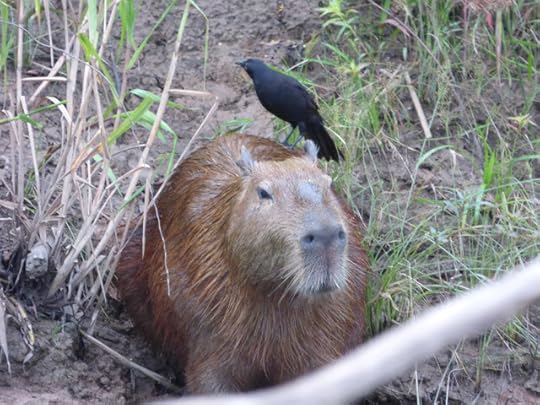 Capybara with cowbird
Capybara with cowbird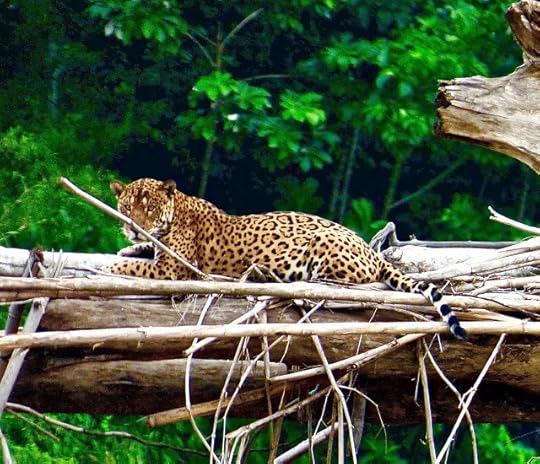 we find a jaguar!
we find a jaguar!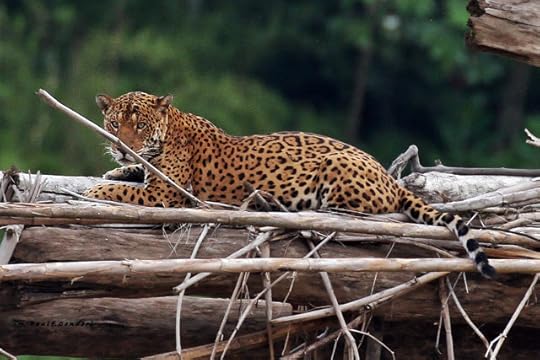 Paul F Condori our guide Jungle Paul's photo
Paul F Condori our guide Jungle Paul's photo White-lipped peccary lookout male watching us as his herd pass, clacking his teeth together to scare us away
White-lipped peccary lookout male watching us as his herd pass, clacking his teeth together to scare us away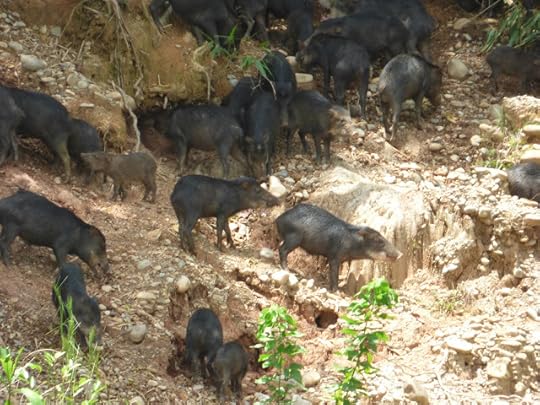 peccary herd at the clay lick
peccary herd at the clay lick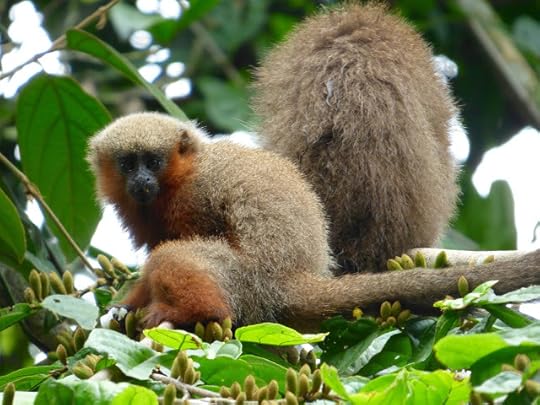 Dusky titi monkey baby with mama, her back to us
Dusky titi monkey baby with mama, her back to us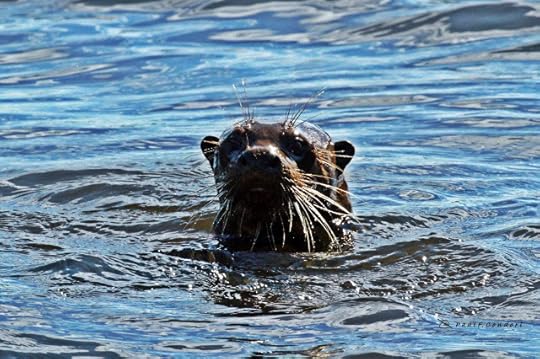 Photo of giant river otter in oxbow lake, following our catamaran, by Paul F Condori
Photo of giant river otter in oxbow lake, following our catamaran, by Paul F Condori Red howler monkeys
Red howler monkeys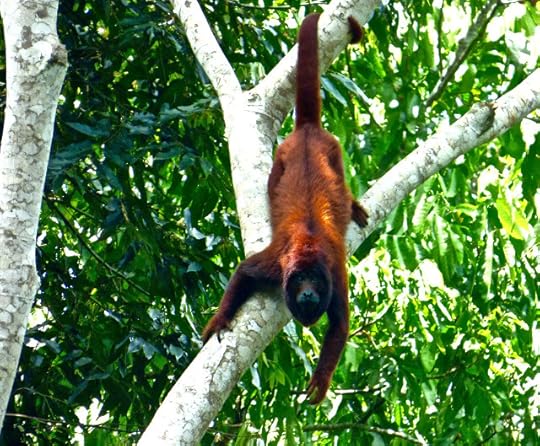 Howler
Howler
Published on September 09, 2017 09:50
September 4, 2017
Some Birds of the Peruvian Amazon, research for Mama Amazonica
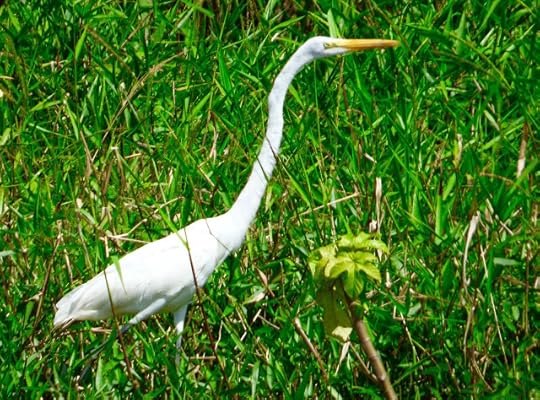 Great egret To celebrate the publication of Mama Amazonica from Bloodaxe this September, here are just some of the birds I saw in the Peruvian Amazon, mostly on the Rio Tambopata banks, and in oxbows or around our lodge Tambopata Research Center. Such glory! The book may deal with trauma, but here is a counterbalance of beauty which I soaked up on my two trips to pristine rainforest. Here is what must be preserved, a world only partly visible, many species as yet undiscovered, unnnamed. Here is what I want to celebrate in my poems, along with the terror.
Great egret To celebrate the publication of Mama Amazonica from Bloodaxe this September, here are just some of the birds I saw in the Peruvian Amazon, mostly on the Rio Tambopata banks, and in oxbows or around our lodge Tambopata Research Center. Such glory! The book may deal with trauma, but here is a counterbalance of beauty which I soaked up on my two trips to pristine rainforest. Here is what must be preserved, a world only partly visible, many species as yet undiscovered, unnnamed. Here is what I want to celebrate in my poems, along with the terror. Most of the photos were taken by Brian Fraser, a few by me with my iPhone, and our guide Jungle Paul took the super-sharp night-hawk.
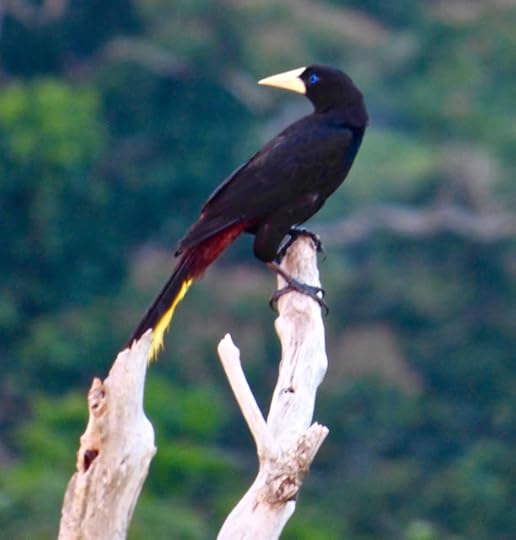 crested oropendola
crested oropendola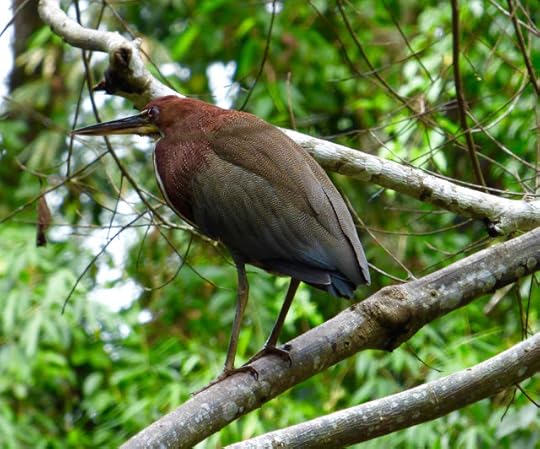 Rufescent tiger heron
Rufescent tiger heron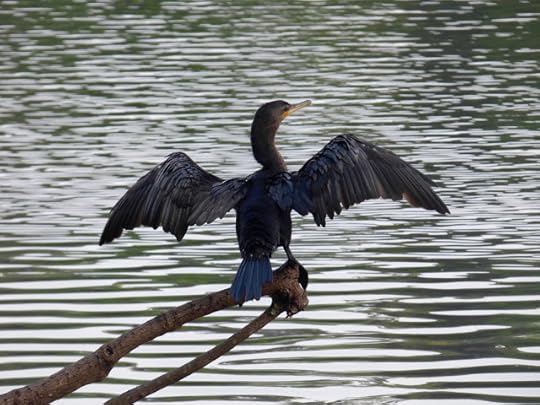 Cormorant in Oxbow Lake
Cormorant in Oxbow Lake Black-tailed trogon
Black-tailed trogon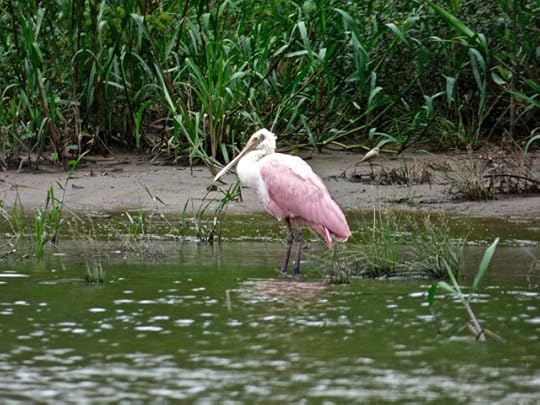 Roseate spoonbill
Roseate spoonbill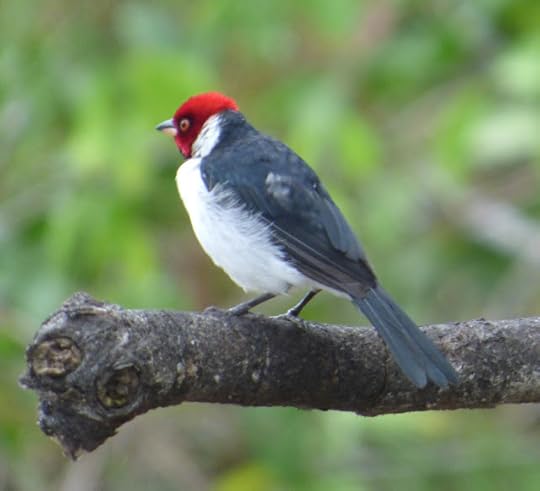 Red-capped cardinal
Red-capped cardinal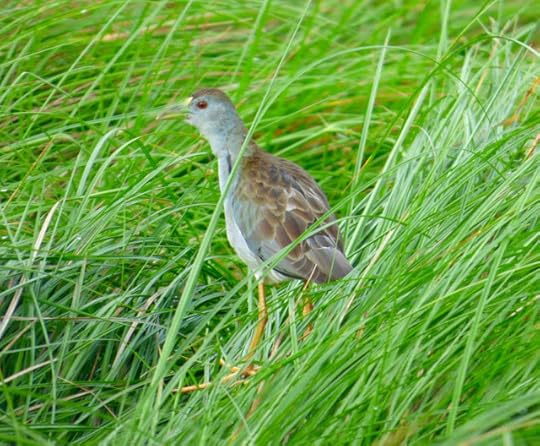 Azure gallinule
Azure gallinule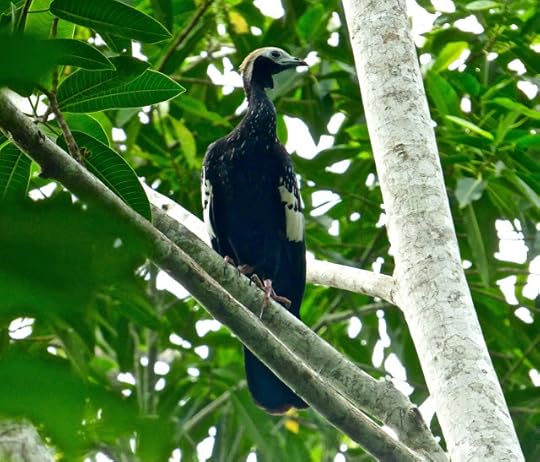 Blue-throated piping guan
Blue-throated piping guan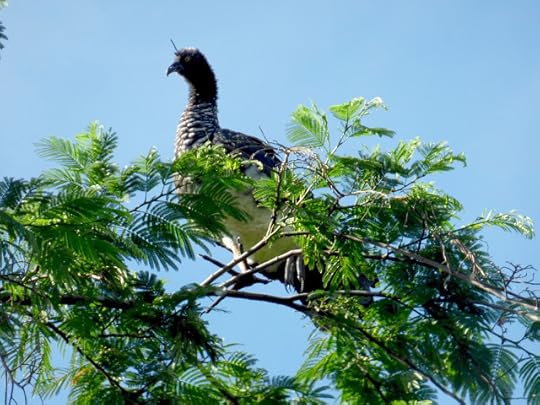 Horned screamer
Horned screamer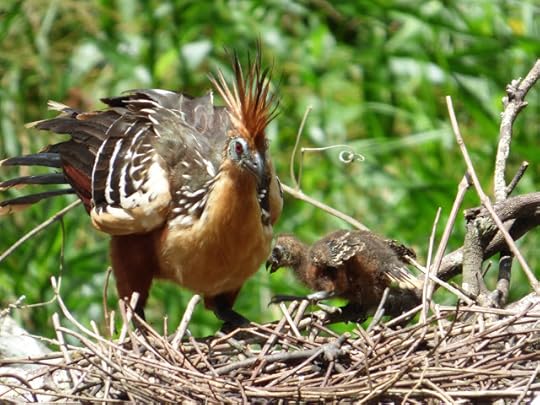 Mama hoatzin with chick in nest on fish pond in island
Mama hoatzin with chick in nest on fish pond in island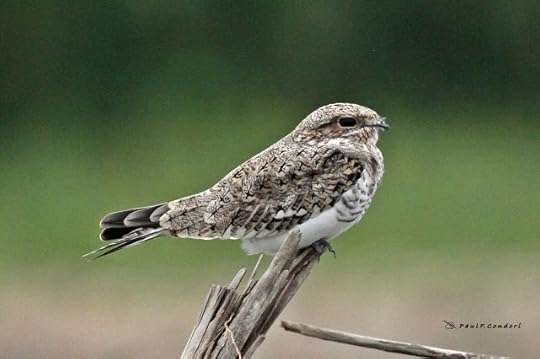 Night hawk on Tambopata photo credit Paul F Condori (Jungle Paul) our guide
Night hawk on Tambopata photo credit Paul F Condori (Jungle Paul) our guide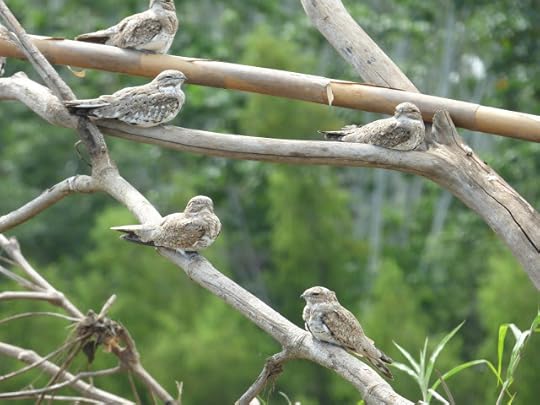 Night hawks on the Tambopata, sleeping on driftwood
Night hawks on the Tambopata, sleeping on driftwood
Published on September 04, 2017 11:31
July 3, 2017
Black Caiman with Butterflies, Mama Amazonica and mental illness

Mama Amazonica will be out later this summer from Bloodaxe, and I'm both excited and nervous. It's already available for preorder on Amazon! And the Poetry Book Society has selected it as their Autumn Choice, which is like a dream. Much of the writing of it was dreamlike, and came from my two trips to the Peruvian Amazon, and much of it came from the terrors of family trauma and mental illness, and a longing to make a book where I could love my psychotic and manic depressive mother. Mania, and depression – that old black caiman, haunt it, as in this poem 'Black Caiman with Butterflies'. The photos were taken by Brian Fraser, on the long journey up the Tambopata River, towards our lodge Tambopata Research Centre, deep in pristine rainforest only accessible by strict border checkpoints, no other lodge in the whole national reserve. <!-- /* Font Definitions */ @font-face {font-family:"MS 明朝"; mso-font-charset:78; mso-generic-font-family:auto; mso-font-pitch:variable; mso-font-signature:-536870145 1791491579 18 0 131231 0;} @font-face {font-family:"Cambria Math"; panose-1:2 4 5 3 5 4 6 3 2 4; mso-font-charset:0; mso-generic-font-family:auto; mso-font-pitch:variable; mso-font-signature:-536870145 1107305727 0 0 415 0;} /* Style Definitions */ p.MsoNormal, li.MsoNormal, div.MsoNormal {mso-style-unhide:no; mso-style-qformat:yes; mso-style-parent:""; margin:0cm; margin-bottom:.0001pt; mso-pagination:widow-orphan; font-size:12.0pt; mso-bidi-font-size:10.0pt; font-family:"Times New Roman"; mso-fareast-font-family:"MS 明朝"; mso-fareast-theme-font:minor-fareast;} .MsoChpDefault {mso-style-type:export-only; mso-default-props:yes; font-size:10.0pt; mso-ansi-font-size:10.0pt; mso-bidi-font-size:10.0pt; mso-fareast-font-family:"MS 明朝"; mso-fareast-theme-font:minor-fareast; mso-ansi-language:EN-US; mso-fareast-language:JA;} @page WordSection1 {size:612.0pt 792.0pt; margin:72.0pt 90.0pt 72.0pt 90.0pt; mso-header-margin:36.0pt; mso-footer-margin:36.0pt; mso-paper-source:0;} div.WordSection1 {page:WordSection1;} </style><br /><br /><div class="MsoNormal"><br /></div><div class="MsoNormal"><span style="font-size: large;"><span style="font-family: "times" , "times new roman" , serif;">Black Caiman with Butterflies</span></span></div><span style="font-size: large;"><span style="font-family: "times" , "times new roman" , serif;"> </span></span><br /><div class="MsoNormal"><span style="font-size: large;"><span style="font-family: "times" , "times new roman" , serif;">Depression is a black caiman<br />lying on the sand,</span></span></div><span style="font-size: large;"><span style="font-family: "times" , "times new roman" , serif;"> </span></span><br /><div class="MsoNormal"><span style="font-size: large;"><span style="font-family: "times" , "times new roman" , serif;">mud-slicked from the deep,<br />impassive in her armour.</span></span></div><span style="font-size: large;"><span style="font-family: "times" , "times new roman" , serif;"> </span></span><br /><div class="MsoNormal"><span style="font-size: large;"><span style="font-family: "times" , "times new roman" , serif;">Nothing can get through to her,<br />she’ll lie there for hours, unblinking.</span></span></div><span style="font-size: large;"><span style="font-family: "times" , "times new roman" , serif;"> </span></span><br /><div class="MsoNormal"><span style="font-size: large;"><span style="font-family: "times" , "times new roman" , serif;">How to explain then<br />the appearance of butterflies?</span></span></div><span style="font-size: large;"><span style="font-family: "times" , "times new roman" , serif;"> </span></span><br /><div class="MsoNormal"><span style="font-size: large;"><span style="font-family: "times" , "times new roman" , serif;">Sparking flambeaux, snowy-whites,<br />at the corner of her eyes, </span></span></div><span style="font-size: large;"><span style="font-family: "times" , "times new roman" , serif;"> </span></span><br /><div class="MsoNormal"><span style="font-size: large;"><span style="font-family: "times" , "times new roman" , serif;">as if the beauty of the world has come<br />to perch on her, to drink her tears.</span></span></div><div class="MsoNormal"><span style="font-size: large;"><span style="font-family: "times" , "times new roman" , serif;"><br /> (previously published in <i>The Poetry Review</i>)</span></span></div><span style="font-size: large;"><span style="font-family: "times" , "times new roman" , serif;"> </span></span><br /><br /><br /><div class="separator" style="clear: both; text-align: center;"><a href="https://2.bp.blogspot.com/-ZnpCoM7KRg..." imageanchor="1" style="margin-left: 1em; margin-right: 1em;"><img border="0" data-original-height="1200" data-original-width="1600" height="480" src="https://2.bp.blogspot.com/-ZnpCoM7KRg..." width="640" /></a></div><br />
Published on July 03, 2017 11:14
May 15, 2017
Mama Amazonica now available for pre-order and is a Poetry Book Society Choice
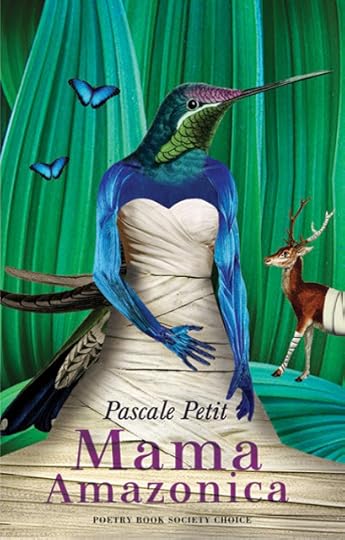
Mama Amazonica is now available for pre-order, from Bloodaxe and Amazon etc. And to my utter delight and surprise is selected as the Poetry Book Society Autumn Choice. It exists – almost – all 112 pages of it. Publication date is 28th September, which happens to also be National Poetry Day!
Pre-order from Bloodaxe: HERE
Pre-order from Amazon.co.uk: HERE
Thank you to Neil Astley at Bloodaxe for encouraging me with it from the very beginning. It did take some courage to write. Here is the official book description:
Mama Amazonica is set in a psychiatric ward and in the Amazon rainforest, an asylum for animals on the brink of extinction. It reveals the story of Pascale Petit’s mentally ill mother and the consequences of abuse. The mother transforms into a giant Victoria amazonica waterlily, and a bestiary of untameable creatures – a jaguar girl, a wolverine, a hummingbird – as she marries her rapist and gives birth to his children. From heartbreaking trauma, there emerge luxuriant and tender portraits of a woman battling for survival, in poems that echo the plight of others under duress, and of our companion species. Petit does not flinch from the violence but offers hope by celebrating the beauty of the wild, whether in the mind or the natural world.
Published on May 15, 2017 09:36
April 29, 2017
On seeing a wild jaguar in the Peruvian Amazon for Mama Amazonica
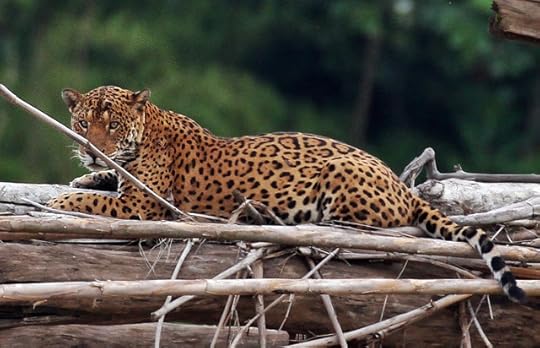
The first time I went to the Peruvian Amazon last June, to Tambopata Research Centre in the middle of a vast protected national park, I hoped to see a jaguar. It's easier to see them in the Brazilian Pantanal, but I wanted to see one in the rainforest, so I knew I was asking the impossible. Everywhere we went we found traces: fresh pug-prints that I placed my hand inside, knowing he/she had just passed, we visited a farm where a jaguar was stealing the farmer's pet cats, other guides showed me photos of jaguars they'd glimpsed along the riverbanks.
Our guide Berli said our only chance of spotting one was to travel up and down the river, so we booked a powered canoe to do this, but alas it rained hard in the Puna mountains, and the Tambopata river rose, bearing massive trunks downstream past our lodge, making the river too dangerous even with a navigator, so those trips were cancelled. Berli told me how he once was on the path by the boatmen's hut, when he came across a jaguar and a puma facing each other. Other guides said they'd seen them swimming across the river or darting among the bamboo stems above the rootmatted banks. I braced myself for the likelihood that a sighting would be brief.
I returned home not exactly disappointed, because I'd seen so much else: a harpy eagle, a tayra, black and spectacled caimans, all the kinds of monkeys endemic to the area, giant river otters. There was much material to weave into my collection Mama Amazonica , the Arts Council funded research was successful. I had precise sense-impressions of the fauna and flora, and the sounds of the forest, which at predawn are otherworldly, with the bats, pale-winged trumpeters, musician wrens, and howler and titi monkey crescendos. I felt I'd immersed myself in primary lowland forest where the mammal population is at its optimum, because no one else, apart from the scientists and guests of TRC, are allowed in the park.
I could write new poems imagining my mentally ill mother as the Amazon rainforest – a journey I'd embarked upon because when I pictured her as animals and plants in the Amazon I was able to love my estranged parent. I wanted a book of this love and I wanted the book to burgeon and floresce, to be a place where the love would grow secretly, have its own eco-system, a memorial to her and to a vanishing wonder.
But a few months later I found myself dreaming of TRC again, a longing that wouldn't leave me alone until I'd booked another trip.
So I went in December, at the start of the rainy season, not the best time to go for rivertrips. But this time we saw even more wildlife than before: giant river otters again, coming up to our catamaran, capybaras mating on the river. We even saw two king vultures perched on the riverside on top of poles, another of my 'special' animals. Despite the rains, with some patience, we saw all the large macaws at the claylicks, and at Chuncho claylick one of the drivers said he'd recently spied a jaguar walking along the top of the cliff, over the clay caves, stalking the gold and blue and scarlet macaws. At the fishing pond I saw hoatzins with their chick in the nest, and at the mammal claylick we watched a harpy eagle chick, high up in the kapok tree nest. We passed roosts of nighthawks on riverlogs. We even came across pale-winged trumpeters on the paths at daytime, and our new guide Jungle Paul mimicked their song so they sang their extraordinary notes that I'd usually hear just before dawn, out in broad daylight.
And so we came to the end of our trip and it was time to go back from TRC, downstream to the lodge in the buffer zone, Refugio Amazonas. We got up at 4 and were through the forest and on the river by 4.45, watching dawn slowly lighting up the banks, the unforgettable sight of steam rising from the trees and mist clearing from the river.
Several hours later we passed the checkpoint at the border of the national park, and that's when Paul whispered 'Gato!!!' Was it an ocelot? No, it was a jaguar! He was lying on a high log above a throne of driftwood, drying his coat after swimming across the rough river. He looked at us and did not move. The engine cut, and our boat gently rocked towards his shore. Paul, the motorista, the navigator and my husband Brian jostled on the narrow prow with their cameras. I sat sideways, facing him, focusing the binoculars. I looked with all my power. Afterwards Paul said we watched him for maybe 10-15 minutes before he descended and vanished, but it felt like hours, some of the best hours of my life, the air glistening like it did on my second wedding day.
The photo of the jaguar was taken by Paul Francisco Condori Vilca.

Published on April 29, 2017 05:50
December 23, 2016
Drama on the Tambopata River, Madre de Dios, Peruvian Amazon

You never know what dramas are unfolding on the Tambopata River in the Peruvian Amazon. We steered the canoe to photograph a great black hawk perched on a dead branch when our motorista saw the huge golden catfish sticking out of the sandbank behind some driftwood. It was only when we got closer that we also saw the spectacled caiman, all two-three metres of him, though mostly he was slunk in the water, his snout in his prey. Our guide Paul Francisco Condori Vilca (aka Jungle Paul) took this photo and the close ups of the caiman's and catfish's heads below. My husband Brian photographed the hawk and the whole scene. They and the motorista and navigator all leapt onto the logs to take photos while I stayed in the boat. I can't leap easily off a narrow canoe prow, being hydrophobic.
Paul explained that great black hawks prey on baby caimans. The hawk was no doubt waiting to feast on the catfish, but the spectacled caiman was waiting for the hawk to descend so he could catch the hawk! They stayed in this deadlock for about twenty minutes, then the caiman pulled the catfish under and re-emerged further back. The female horseflies on the catfish were also on the caiman's head, they too were waiting for a meal. It was a spectacular find, and back at Tambopata Research Center that evening we toasted it with pisco sours before falling into bed at nine, for the usual four am rise.
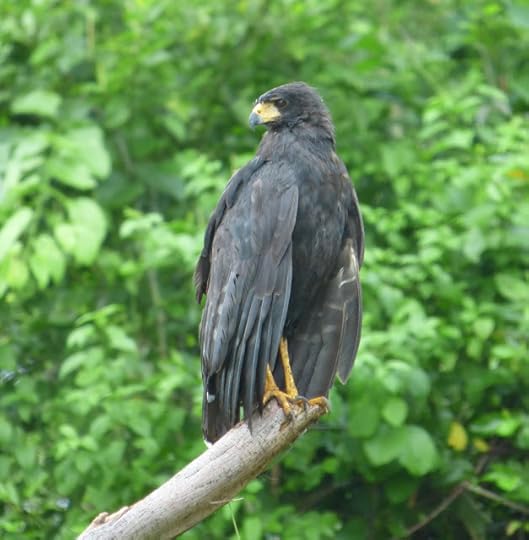
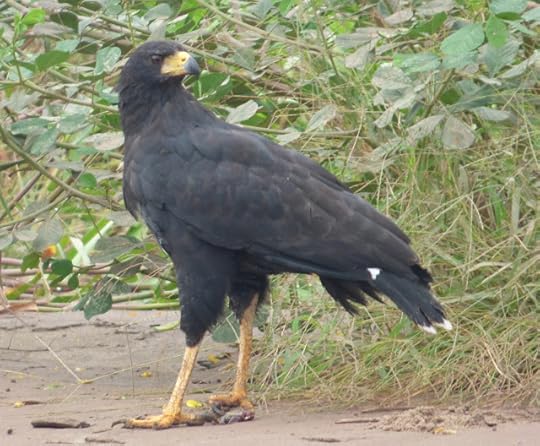
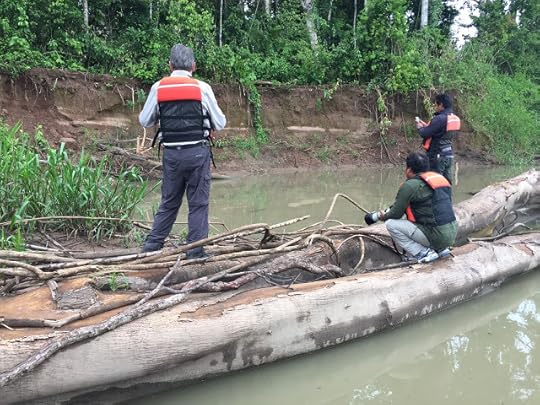
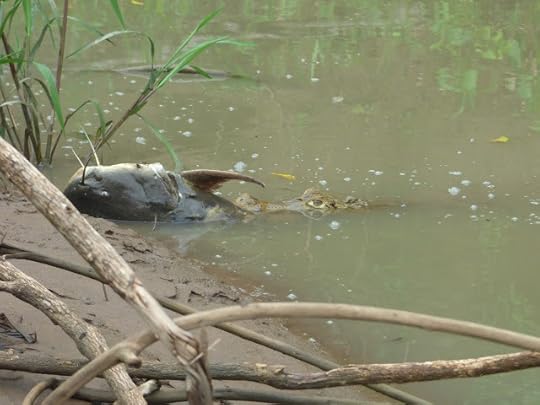
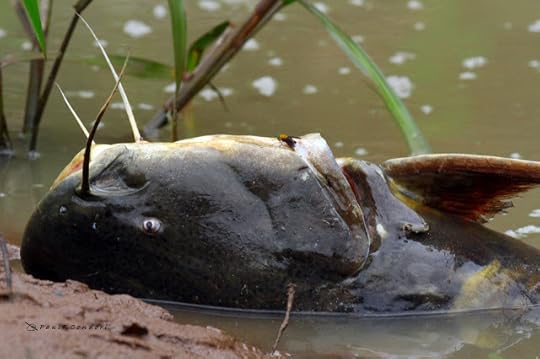
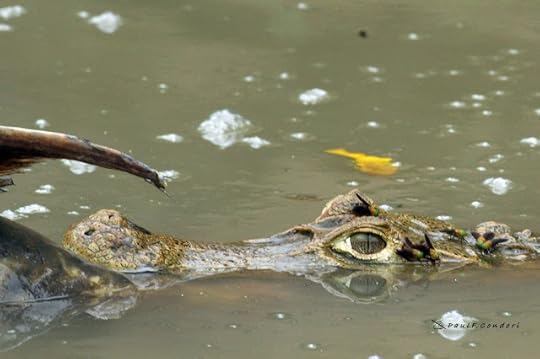
Published on December 23, 2016 11:00
December 20, 2016
Second Trip to the Peruvian Amazon, Tambopata National Reserve, Madre de Dios region
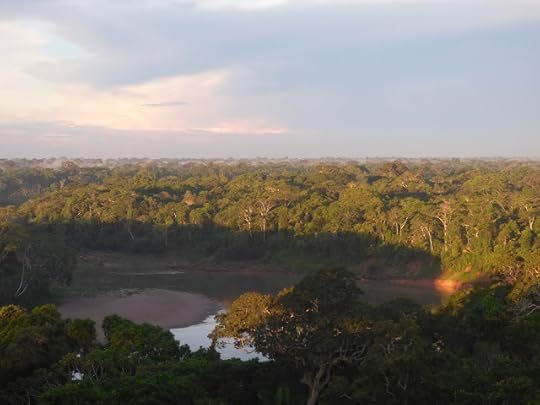
This is the view from the top of the 30 meter scaffolding canopy tower over the Madre de Dios rainforest, late afternoon, taken on the first day of our arrival in the Peruvian Amazon, when we stayed in a lodge in the outer buffer zone of the Tambopata National Reserve, one hour upriver from the Ese'Eja native community of Infierno. This particular lodge, Posadas, is in the Ese'Eja's protected primary forest, which means there is a high diversity of creatures, many of which can be seen from the bedrooms, which are missing an outer wall. It is possible to lie in bed and watch monkeys and toucans flying through the trees.
On this, our second trip to the Peruvian Amazon basin, we saw so much wildlife, took so many photos, that I'm starting the blog with just the landscape and the trees, the rainforest and the Tambopata River, its oxbow lakes and creeks, islands and ponds. We trekked in the heat and humidity and mosquito clouds of the wet season. Luckily, although we arrived in rain, and the forecast was for rain and thunder every day and night, we only had one afternoon of deluge, when all excursions were cancelled. There were occasional spectacular night storms, surprise downpours, and lots of sun, not that we could see it in the forest understorey where it is always twilight.
After two days in Posadas Lodge we went upriver six and a half more hours, deep into the pristine Tambopata National Reserve, to stay at Tambopata Research Station. There are no other humans allowed in this national park so the forest is undisturbed. It was my second stay there, and I could get addicted to it, despite the discomfort of always being sweaty, having to take three showers a day and having to wear gumboots for the mud, and cover up from neck to toe against the insect hordes and spray insect repellant every half an hour. We got up at 4am most days, fumbling in the dark with torches, and the best experiences were usually those treks and boat-trips before breakfast, when the wildlife was at its peak.
The highlight was a jaguar. But there were other equally enthralling encounters: the giant river otters that swam towards our catamaran, a king vulture on river logs, capybaras mating, a harpy eagle chick, a hoatzin chick, a large caiman eating an even larger catfish, nighthawks roosting on the river, a scissor-tail kite – the list goes on. Almost all spotted by our eagle-eyed guide Jungle Paul, who also took some of the best photos with his huge zoom-lens camera. Most of these pics here I took with my iPhone, which is good for landscapes and also for close-ups. But I didn't take the view from the canopy tower, sadly my vertigo prevents me getting up there. I did try on our last trip, and almost got to the top, then the narrowing and steeper steps started to sway with the slightest breeze and I was spooked.
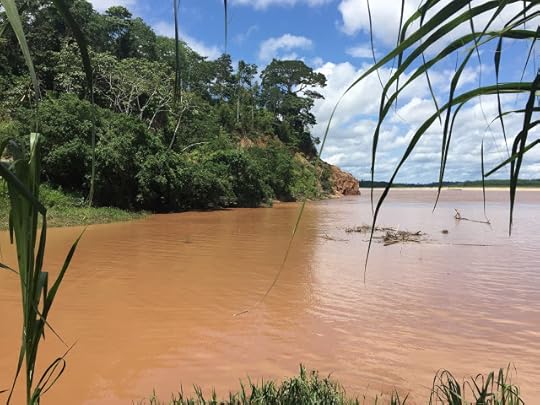 The creek entrance to Colorado clay lick and the island observation pond, here I am waiting for the boat to take us back to TRC. The colours!
The creek entrance to Colorado clay lick and the island observation pond, here I am waiting for the boat to take us back to TRC. The colours!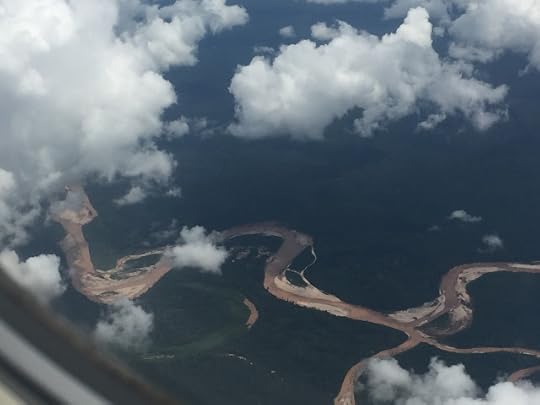 View of the Madre de Dios rivers from the plane from Cusco to Puerto Maldonado
View of the Madre de Dios rivers from the plane from Cusco to Puerto Maldonado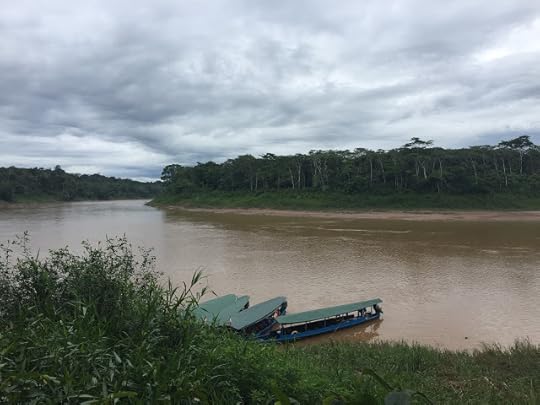 TRC port
TRC port 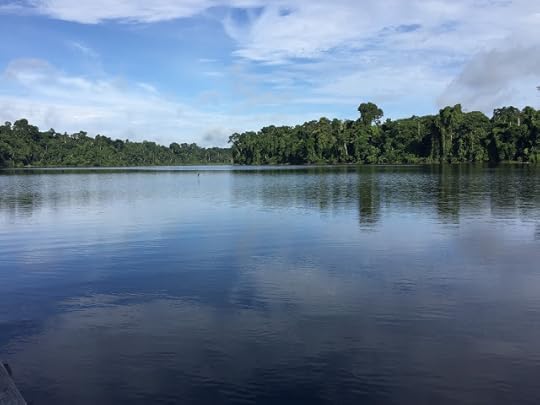 Tres Chimbadas Oxbow Lake, a solitary cormorant in the far distance on a branch sticking out of the water
Tres Chimbadas Oxbow Lake, a solitary cormorant in the far distance on a branch sticking out of the water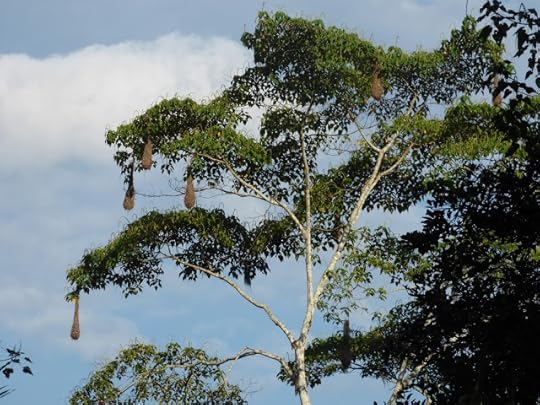
Oropendola nests
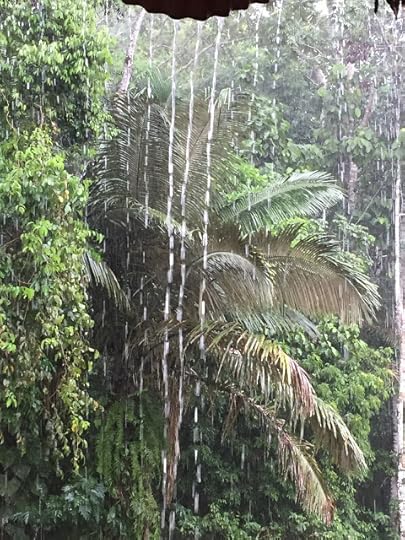
The afternoon deluge

The oxbow lake Tres Chimbadas where we saw the giant river otters
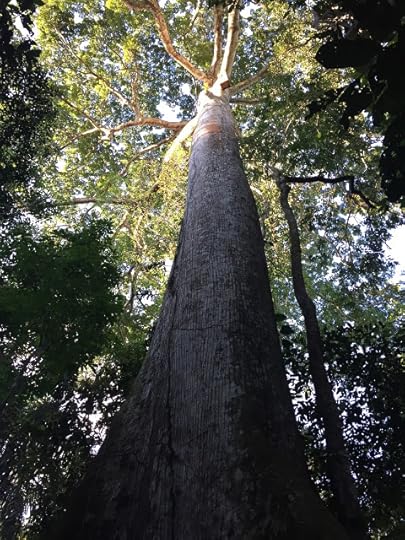
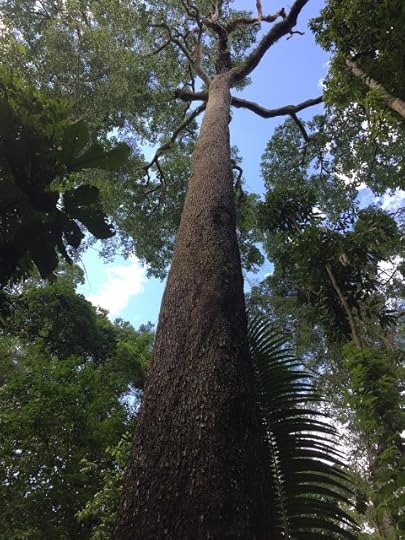
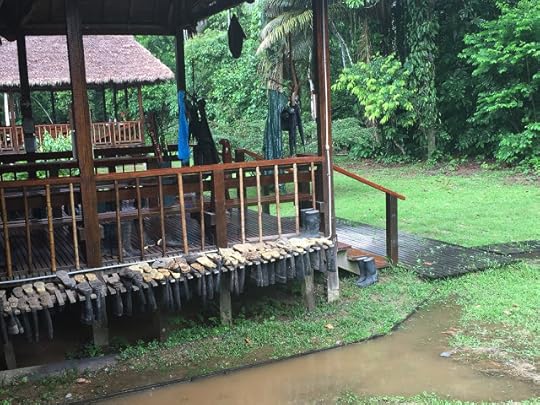 The men's gumboot rack, the women's is on the other side of the entrance to TRC. This is mainly for the scientists and their assistants, young people who can climb giant trees like monkeys to monitor macaw nests
The men's gumboot rack, the women's is on the other side of the entrance to TRC. This is mainly for the scientists and their assistants, young people who can climb giant trees like monkeys to monitor macaw nests
Published on December 20, 2016 09:34
September 27, 2016
Beach studies, St Bees Cumbria, and the Elements Festival launch!
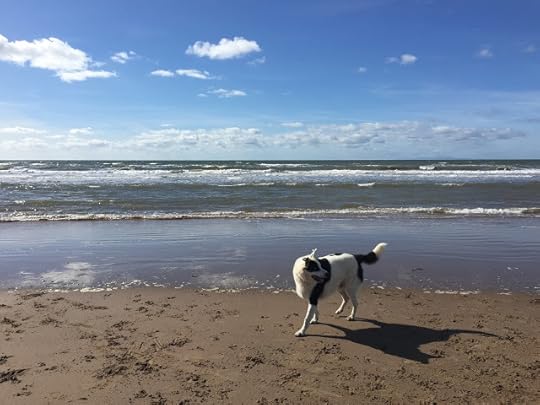
I've been on St Bees beach in a large caravan for over a month now, with a view onto the open sea, from my temporary home three vans back from the front. I can also see the sandstone head, its rocks and rockpools. The other cliffs south of the beach are limestone, though these too are red. Now that it's almost October the default weather is wind that rocks the caravan, sometimes driving rain, and yet the clouds can suddenly clear and the sky turn dazzling blue. I've done quite a bit of writing here, as well as teaching, on my West Lakes residency, and in just over a week's time I'll be home, then off to work elsewhere, but I'll be back mid October for a series of events for the visionary Elements Festival, which is all about diversity and minorities, and over 60's, quite a feat for such a rural outpost, thanks to Tonia Lu who dreamt it all up. I'll read some of my brand new residency inspired poems at the launch of the festival this Saturday, at Penrith Fire Station.
The sea itself has swept into me, in all its terrifying splendour, the St Bees sandstone also has fed into the poems, one was written in Fleswick Bay, when I had it all to myself one glorious August day, and another aspect that's gradually seeped into my bones is the iron ore mining of Copeland's industrial past – our workshops are held in Florence Mine, where the miners' shower rooms are converted into a beautiful arts centre. This has led me to research my own mining past, in the depressed coal mining village of Llanbradach in the Rhymni valley, south Wales, where I lived with my estranged mother as a teenager for five years, under the shadow of the slagheap. She lived there much longer. I'm thrilled that I've written about this for the first time ever, because what a fascinating thing coal is, and the shallow sea-swamps of the Carboniferous, with their mega-insects!
The Irish Sea is wild in wind, roars like an open furnace, sometimes it's white with fume over glassy waves, sometimes bronze, pewter, or polished aluminium. People aren't swimming in it anymore, not even paddling, though on my daily walks along the mile wide sands that are revealed at low tide I wear sandals so I can paddle through the channels that lace the shore. People mainly walk their dogs, usually in pairs, only a few family groups left. It's unusual to come across others walking alone, but when I do I tend to take photos (all these are with my iphone), and there are boats alone out there, sometimes paragliders above me too. For me, these frames of walkers, dogs with their shadows, seabirds, whether they're oyster catchers, a heron, or gulls, or boats alone on the horizon, are studies in solitude.
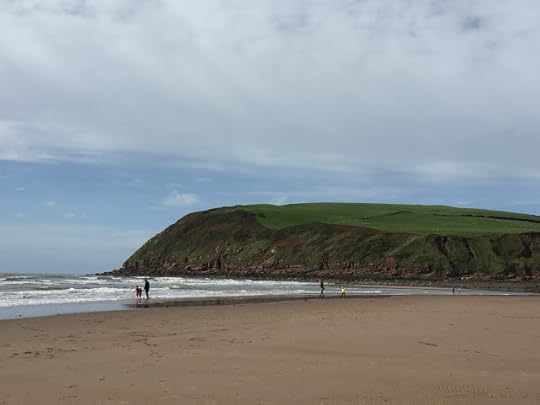
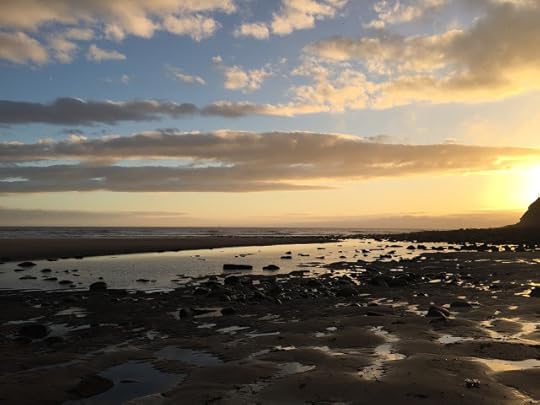
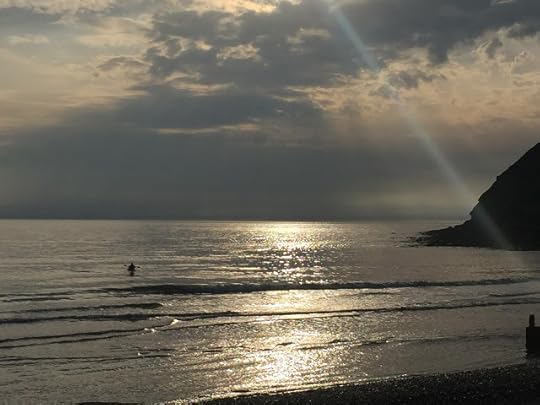
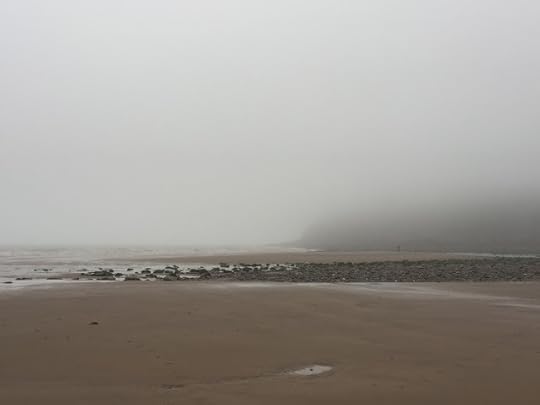
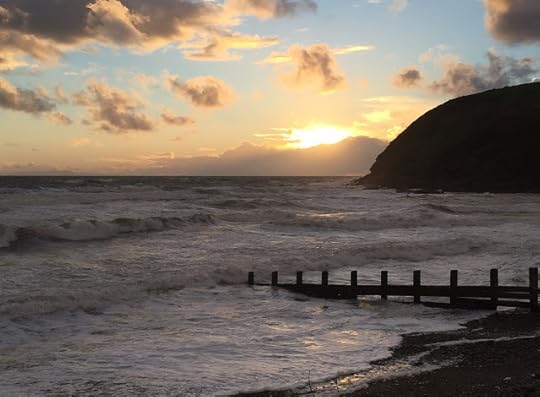
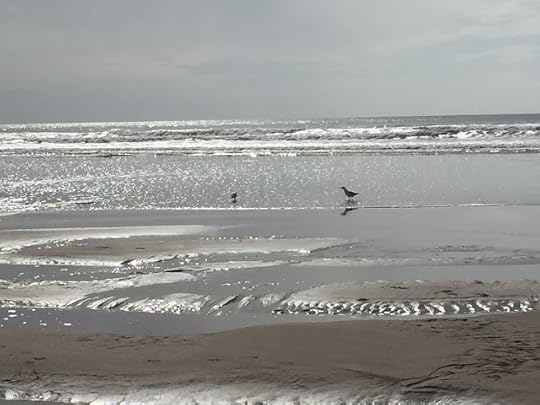
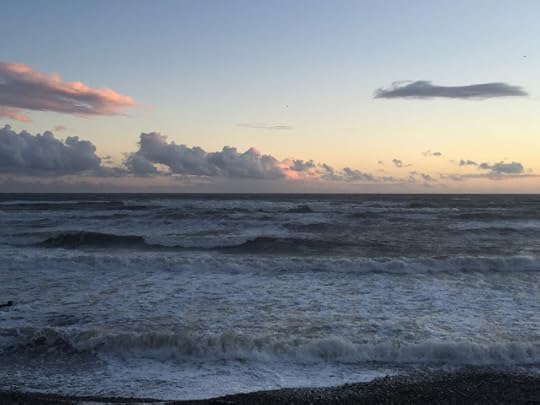
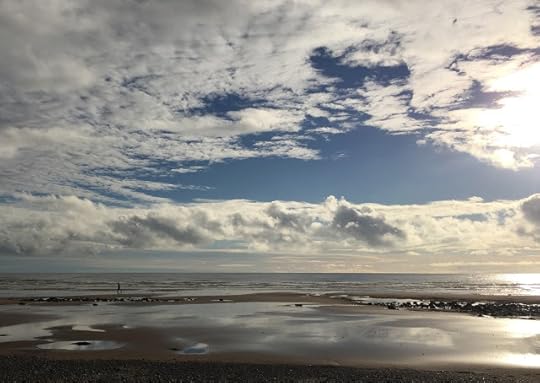
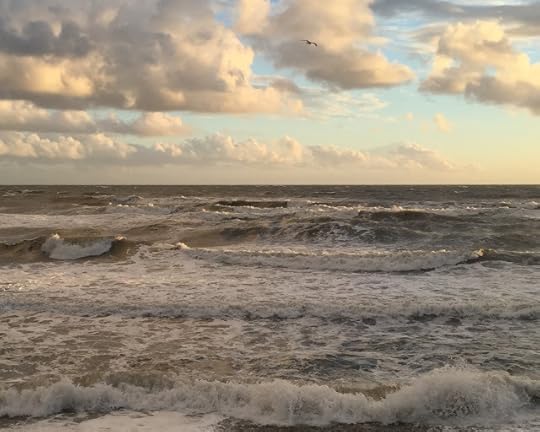
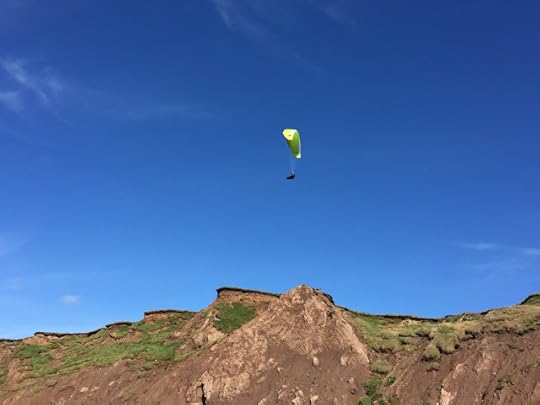
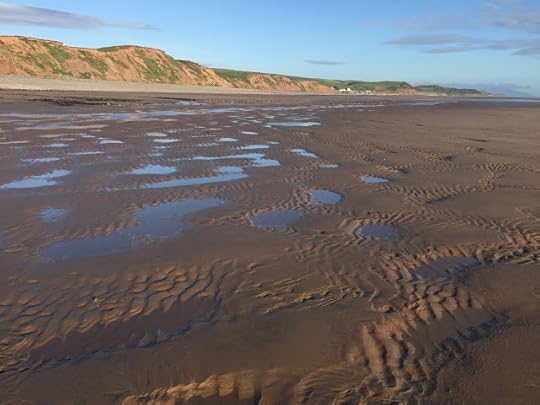
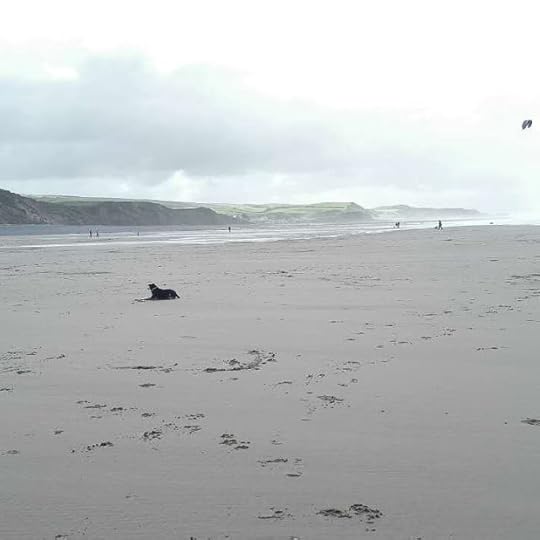
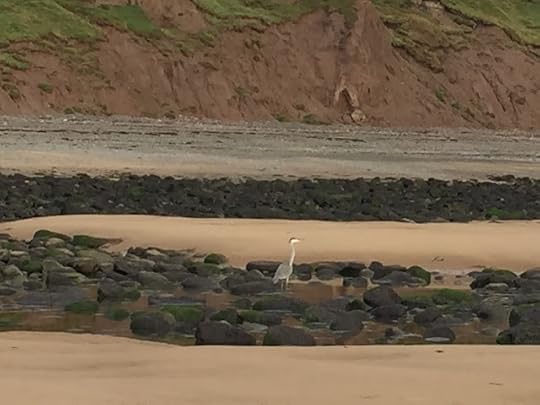
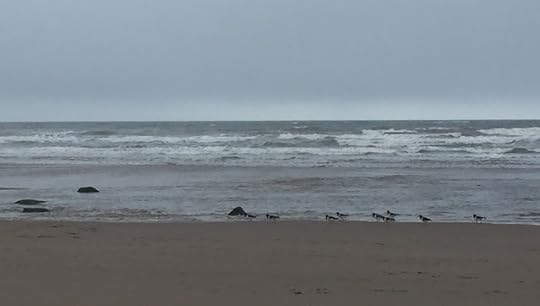
Published on September 27, 2016 12:18
September 9, 2016
The Lion's Mane Jellyfish of West Cumbria
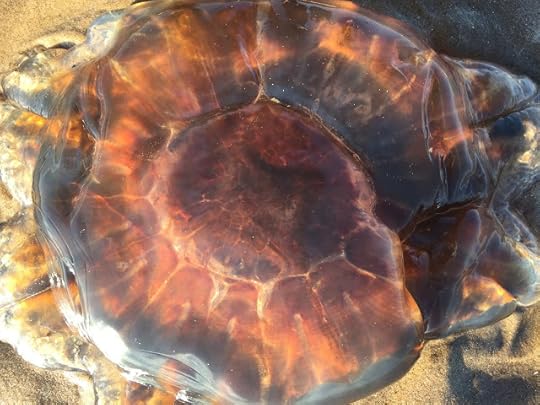
Imagine coming across this on the beach. When I found my first, I took a photo and back in my caravan at St Bees, tried to identify it on google images. I guessed it was a jellyfish as it wobbled slightly when touched with a shell, but it could have been a giant eye, it looked like a giant eye washed up after the night's storm. It was surrounded by smaller blobs without the luminous red and tan colours. Those smaller clear jellyfish I'd seen before on other beaches, but my creature looked like it might be a lion's mane jellyfish. And the smaller clear ones? Moon jellies that the lions feed on! The lions that haunt Arctic waters can grow to be the largest jellyfish in the world, but these ones in the Irish Sea are more modest, the largest I found was a foot across.
Since then I've been obsessed by these sea-cats and the process of seeing them is quite strange. Once I see one I look around and usually find others scattered nearby. What's more, my feet seem to know where to walk, as if they've developed eyes. I think I've seen about fifteen by now, and some are striped like tigers or mint humbugs. Maybe one or two were compass jellyfish? Some have more mane to them and these larger ones have 'eyes' that look more like organs, bloodied even, like they've met with a violent death. I want to see more but I'm also aware these are freshly dead creatures and I don't want them to die.
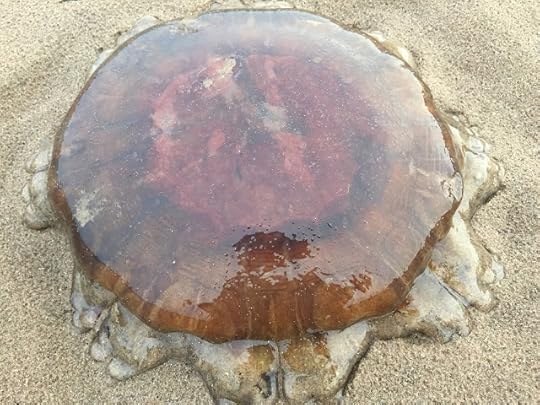

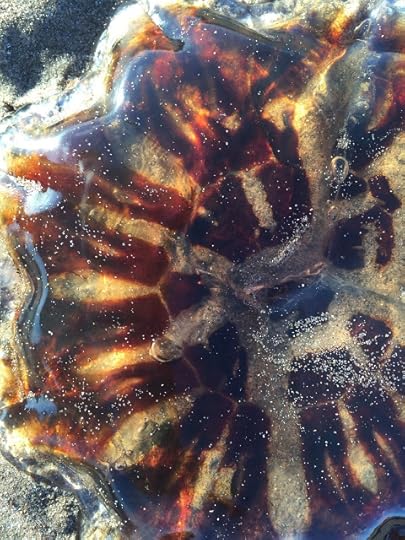
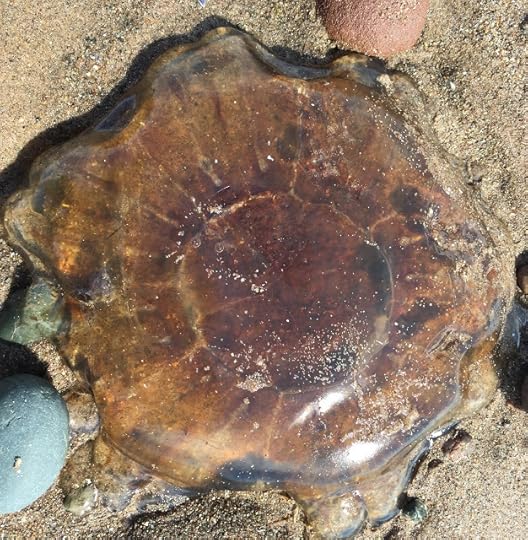
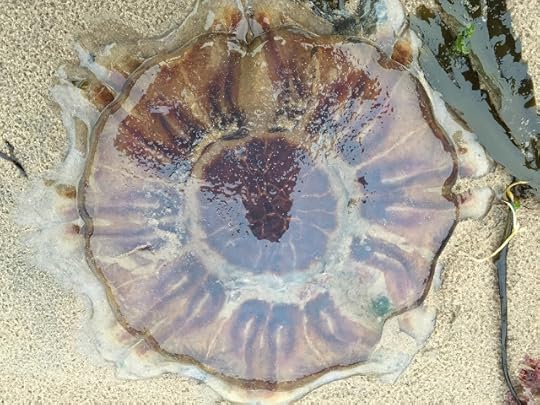
Published on September 09, 2016 23:28



